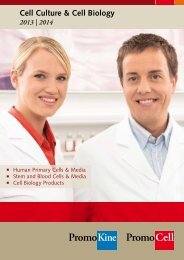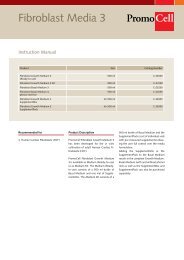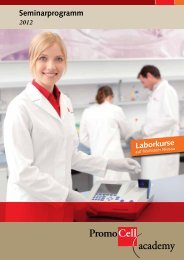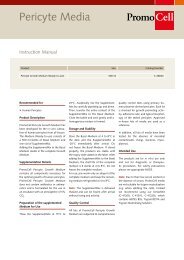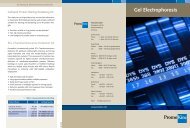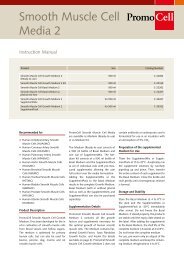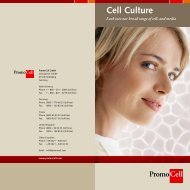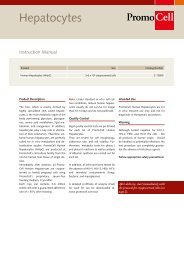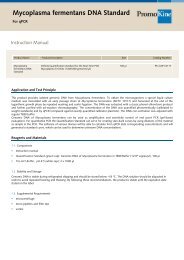PCR Mycoplasma Test Kit II - PromoCell
PCR Mycoplasma Test Kit II - PromoCell
PCR Mycoplasma Test Kit II - PromoCell
You also want an ePaper? Increase the reach of your titles
YUMPU automatically turns print PDFs into web optimized ePapers that Google loves.
4 Instruction Manual<br />
Instruction Manual<br />
5<br />
Required Reagents and Equipment<br />
Reagents not supplied in the kit<br />
• Mineral oil (if using thermal cycler without heated lid)<br />
• Agarose gel<br />
• Distilled sterile water<br />
Equipment required<br />
• Authorized thermal cycler for <strong>PCR</strong><br />
• Microcentrifuge tubes<br />
• Agarose gel electrophoresis apparatus<br />
• Microcentrifuge<br />
• Micropipets and pipette tips (autoclaved)<br />
Storage<br />
Store at -20 o C.<br />
Avoid repeated changes in the Reaction Mix temperature<br />
When in use, always keep the Reaction Mix on ice!<br />
Principle<br />
rRNA gene sequences of prokaryotes, including mycoplasmas, are well<br />
conserved, whereas, the lengths and sequences of the spacer region in<br />
the rRNA operon (for example the region between the 16S and 23S<br />
genes) differ from species to species. The detection procedure utilizing<br />
the <strong>PCR</strong> process with this primer set consists of:<br />
1. Amplification of a conserved and mycoplasma-specific 16S rRNA<br />
gene region using two primers.<br />
2. Detection of the amplified fragment by agarose gel<br />
electrophoresis.<br />
This system does not allow the amplification of DNA originating from<br />
other sources, such as tissue samples or bacteria, which affect the<br />
detection result. Amplification of the gene sequence by <strong>PCR</strong> using this<br />
primer set enhances not only the sensitivity, but also the specificity of<br />
detection. Amplified products are then detected by agarose gel<br />
electrophoresis.<br />
Protocol<br />
<strong>Test</strong> sample preparation<br />
Transfer 0.5-1.0 ml cell culture supernatant into a 2 ml centrifuge<br />
tube. To pellet cellular debris, centrifuge the sample at 250 x g briefly.<br />
Transfer the supernatant into a fresh sterile tube and centrifuge at<br />
15,000-20,000 x g for 10 minutes to sediment mycoplasma. Carefully<br />
decant the supernatant and keep the pellet (the pellet will not always<br />
be visible). Re-suspend the pellet with 50 μl of the Buffer Solution and<br />
mix thoroughly with a micropipet. Heat to 95 o C for 3 minutes. The<br />
test sample can be stored at this stage at -20°C for later use.<br />
<strong>PCR</strong> amplification<br />
1. Prepare the reaction mixture in a <strong>PCR</strong> tube by combining the<br />
reagents shown below:<br />
Reagents<br />
H2O<br />
Reaction Mix<br />
<strong>Test</strong> sample<br />
Volume<br />
35 μl<br />
10 μl<br />
2. If not using a thermal cycler having a heated lid, overlay mixture<br />
with mineral oil (approximately 40 μl) to avoid evaporation of the<br />
reaction mixture.<br />
3. Place all tubes in a <strong>PCR</strong> thermal cycler. Set the parameters for the<br />
following conditions and perform the <strong>PCR</strong>.<br />
5 μl



